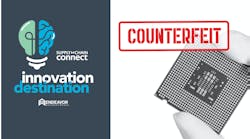Download this article in PDF format.
The growing prevalence of counterfeit products around the globe poses serious threats to economic security and human health. Knowing this, a team of researchers in Asia are developing advanced anti-counterfeiting materials with physical “unclonable functions.” The team created diamond-based anti-counterfeiting labels that are unique and known in the industry as physically unclonable functions (PUFs), and have published their findings in Nature Communications.
“Counterfeiters and anti-counterfeiters are now locked in a technological arms race,” the University of Hong Kong states in “Using diamond microparticles to create high security anti-counterfeit labels.” “Despite anti-counterfeiting tools becoming more and more high-tech—including holograms, thermochromic ink and radio frequency identification tags, fake products are becoming harder and harder to tell apart from the genuine articles because counterfeiters are using increasingly advanced technology.
What is a PUF?
By definition, PUFs are devices that exploit the inherent randomness introduced during manufacturing. They give a physical entity a unique “fingerprint” or trust anchor that can be used in a variety of applications—from anti-counterfeiting to identification to authentication, to name just a few.
Led by Dr. Zhiqin Chu of the Department of Electrical and Electronic Engineering of the University of Hong Kong, the research made diamond-based anti-counterfeiting labels by planting tiny artificial diamond microparticles on a silicon plate using a method called Chemical Vapor Deposition (CVD).
The diamond microparticles, all different in shape and size, form a unique pattern when they scatter on the silicon substrate, the University of Hong Kong reports: “Such [a] pattern is impossible to replicate and therefore scatters light in a unique way. Put simply, it forms a unique ‘fingerprint’ that can be scanned using a phone.”
Silicon-Vacancy Centers
An additional layer of security comes from the fact that these diamond microparticles have defects known as silicon-vacancy (SiV) centers, which give diamond microparticles a unique optical property. Because they emit near-infrared photoluminescence when a green light is shined on them, the microparticles are easily identifiable.
“These unique optic signatures can then be combined and digitized into codes of very high sophistication and security that can be read by a simple smartphone scanner and/or a confocal fluorescence microscope,” the university adds, noting that the diamond-based labels are “highly suitable” for the use in commercial products as they are extremely tough (in the trials they withstood heat, the action of chemicals and physical damage).
“By combining these two phenomena, it’s reportedly possible to create a near-infinite number of one-off ‘optical fingerprints’ that can't be replicated, but that can be easily read by a smartphone-connected scanner or a confocal fluorescence microscope,” Ben Coxworth writes in “Anti-counterfeiting tech draws on unique qualities of micro-diamonds.” “The idea is that if a user wanted to check the authenticity of a product, they could just see if its scanned fingerprint matched any which were stored in the manufacturer's online database.”
Tough and Inexpensive
Various anti-counterfeiting strategies—including watermarks, holograms, barcodes and two-dimensional codes—have been developed in recent decades to prevent counterfeiting, the researchers note in their report. “However, most of these tags are fabricated by reproducible deterministic processes, making the encoded information vulnerable to third parties who possess the relevant expertise.”
As such, there is now an “urgent need” to develop unbreakable anti-counterfeiting tags to combat the growing global prevalence of counterfeiting. In summary, the research team says the advanced anti-counterfeiting material they’ve discovered may lead to the “immediate development of a robust, dynamic, trustworthy, and intelligent anti-counterfeiting strategy.”
The researchers say their diamond-based labels are tough enough to withstand heat, harsh chemicals and physical abuse, and that they’re also fairly inexpensive to make. According to the research team, 10,000 labels measuring 200 × 200 micrometers each could be produced for just $1 U.S.









